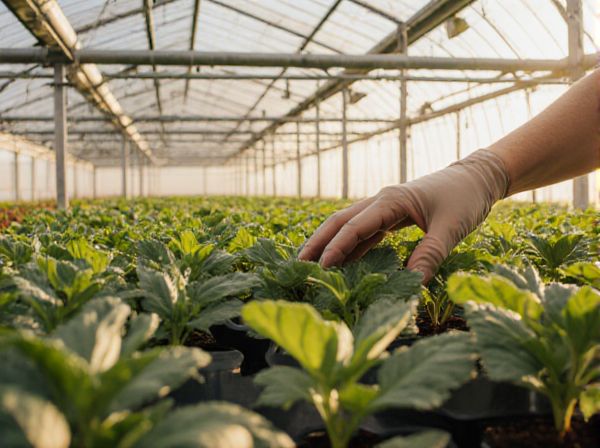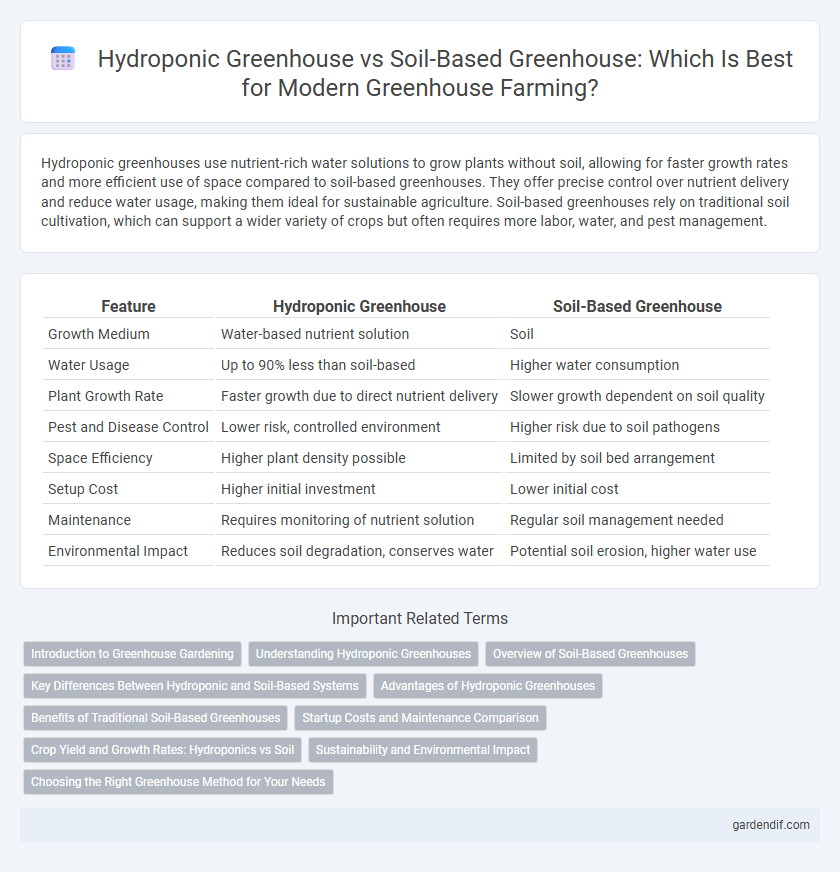
Hydroponic Greenhouse vs Soil-Based Greenhouse Illustration
Hydroponic greenhouses use nutrient-rich water solutions to grow plants without soil, allowing for faster growth rates and more efficient use of space compared to soil-based greenhouses. They offer precise control over nutrient delivery and reduce water usage, making them ideal for sustainable agriculture. Soil-based greenhouses rely on traditional soil cultivation, which can support a wider variety of crops but often requires more labor, water, and pest management.
Table of Comparison
| Feature | Hydroponic Greenhouse | Soil-Based Greenhouse |
|---|---|---|
| Growth Medium | Water-based nutrient solution | Soil |
| Water Usage | Up to 90% less than soil-based | Higher water consumption |
| Plant Growth Rate | Faster growth due to direct nutrient delivery | Slower growth dependent on soil quality |
| Pest and Disease Control | Lower risk, controlled environment | Higher risk due to soil pathogens |
| Space Efficiency | Higher plant density possible | Limited by soil bed arrangement |
| Setup Cost | Higher initial investment | Lower initial cost |
| Maintenance | Requires monitoring of nutrient solution | Regular soil management needed |
| Environmental Impact | Reduces soil degradation, conserves water | Potential soil erosion, higher water use |
Introduction to Greenhouse Gardening
Hydroponic greenhouses use nutrient-rich water solutions to grow plants without soil, enabling higher yields and more efficient resource use compared to traditional soil-based greenhouses. Soil-based greenhouses rely on natural growing mediums, offering benefits like improved soil health and microbial activity but may have slower growth rates and greater susceptibility to pests. Both systems provide controlled environments to optimize plant growth, with hydroponic methods excelling in water conservation and nutrient management.
Understanding Hydroponic Greenhouses
Hydroponic greenhouses use nutrient-rich water solutions instead of soil to grow plants, allowing for precise control over nutrient delivery and water usage. This method significantly reduces the risk of soil-borne diseases and pests, leading to healthier crops and higher yields. Advanced hydroponic systems enable faster plant growth cycles and efficient space utilization compared to traditional soil-based greenhouses.
Overview of Soil-Based Greenhouses
Soil-based greenhouses utilize natural soil as the growing medium, offering plants essential nutrients and microbial life that support robust root development. They provide a traditional cultivation environment with less dependency on technology compared to hydroponic systems, making them accessible for various scale operations. Maintenance involves managing soil health through crop rotation, fertilization, and pest control to ensure sustained productivity and plant growth.
Key Differences Between Hydroponic and Soil-Based Systems
Hydroponic greenhouses utilize nutrient-rich water solutions to grow plants without soil, enabling precise control over nutrient delivery and reducing water usage by up to 90% compared to soil-based systems. Soil-based greenhouses rely on natural soil substrates, which support complex microbial ecosystems and require longer growth cycles due to variable nutrient availability. Hydroponic systems typically yield 25-50% higher crop production per square meter and allow for year-round cultivation through optimized environmental controls.
Advantages of Hydroponic Greenhouses
Hydroponic greenhouses offer significant advantages over soil-based systems, including faster plant growth rates and higher yield efficiency due to precise nutrient control and optimized water use. These systems reduce soil-borne diseases and minimize the need for pesticides, creating a cleaner and more sustainable growing environment. Hydroponic greenhouses also enable year-round cultivation with improved space utilization, making them ideal for urban farming and regions with limited arable land.
Benefits of Traditional Soil-Based Greenhouses
Traditional soil-based greenhouses offer enhanced nutrient cycling and natural microbial activity, which improve plant health and yield. Soil acts as a buffer for water retention and temperature regulation, reducing irrigation needs and stress on plants. This method supports biodiversity and sustainable farming practices by maintaining soil structure and fertility over time.
Startup Costs and Maintenance Comparison
Hydroponic greenhouses generally require higher startup costs due to investments in specialized equipment, nutrient delivery systems, and climate control technology, whereas soil-based greenhouses incur lower initial expenses primarily linked to traditional soil preparation and planting materials. Maintenance costs in hydroponic systems tend to be more consistent and manageable, as automated nutrient management and pest control reduce labor and resource use, contrasting with soil-based greenhouses where frequent soil treatment and pest management can increase ongoing expenses. The choice between these greenhouse types significantly impacts budget planning, with hydroponics offering long-term operational efficiency at the expense of initial capital outlay.
Crop Yield and Growth Rates: Hydroponics vs Soil
Hydroponic greenhouses deliver significantly higher crop yields and faster growth rates compared to soil-based greenhouses due to precise nutrient delivery and controlled environment conditions. Studies show hydroponic systems can increase crop production by up to 30-50%, while plants often mature 25-30% quicker than those grown in traditional soil media. Optimized irrigation and reduced pest exposure in hydroponic greenhouses further enhance plant health and productivity, making them highly efficient for commercial farming.
Sustainability and Environmental Impact
Hydroponic greenhouses significantly reduce water usage by up to 90% compared to soil-based systems, enhancing sustainability through efficient resource management. They eliminate the need for chemical pesticides and fertilizers, minimizing soil degradation and preventing nutrient runoff, which protects surrounding ecosystems. Energy consumption in hydroponic systems can be optimized with renewable technologies, leading to a smaller carbon footprint relative to traditional soil-based greenhouses.
Choosing the Right Greenhouse Method for Your Needs
Hydroponic greenhouses offer precise nutrient control and faster plant growth, making them ideal for high-efficiency, space-limited environments. Soil-based greenhouses provide natural microbial ecosystems beneficial for traditional crops and often require lower initial setup costs. Selecting the right greenhouse method depends on factors such as crop type, budget constraints, space availability, and desired yield optimization.
Hydroponic Greenhouse vs Soil-Based Greenhouse Infographic

 gardendif.com
gardendif.com